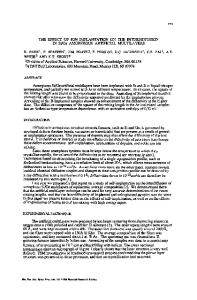Interdiffusion of Amorphous Si/Ge Multilayers Under Hydrostatic Pressure
- PDF / 378,349 Bytes
- 6 Pages / 414.72 x 648 pts Page_size
- 110 Downloads / 398 Views
STEVEN D. THEISS, S. MITHA, F. SPAEPEN AND M.J. AZIZ Division of Applied Sciences, Harvard University, Cambridge, MA 02138
ABSTRACT We report initial results of an x-ray diffraction study of the pressure-dependence of the interdiffusion rate in amorphous Si/Ge multilayers. Anneals were performed in a diamond anvil cell at 700 K for various pressures and durations. Interdiffusion was measured by monitoring the rate of decay of the artificial Bragg peaks associated with the multilayer periodicity. A consistent increase in diffusivity was seen with pressure, characterized by an activation volume of -25±11 percent of the atomic volume of Si. An atomistic mechanism that might account for such behavior is discussed.
INTRODUCTION The nature of the defects in amorphous semiconductors is not well understood. Given that a number of important properties such as diffusion rates [1] and electrical conductivity [2] are controlled by defects, it is highly desirable to develop a more complete and accurate picture of these defects. Unlike their crystalline counterparts where defects are well defined, it is likely that defects present in amorphous semiconductors exist in a continuum of states and configurations. However, it is still possible to conceptualize the existence of defects that have similar character to those present in crystalline materials, specifically the vacancy and the interstitial. While interstitial defects in amorphous materials might be quite similar in behavior to those in crystalline materials, the absence of periodicity would allow the unfulfilled bonds left over from the removal of an atom (i.e. a vacancy) to migrate and become individual "dangling" bonds. Although no direct evidence exists for the presence of interstitial defects, ESR experiments have demonstrated the existence of singly-occupied electronic states, which is widely regarded as evidence for the existence of neutral dangling bonds [3]. It has also been predicted that "floating" bonds, or over-coordination defects, exist in amorphous Si (a-Si) [4] The purpose of the present study is to help elucidate the role of defects in mass transport in amorphous semiconductors by looking at the effects of hydrostatic pressure on interdiffusion in a-Si/a-Ge multilayers. Given the chemical similarity of these two materials, it should eventually be possible to extend the understanding gained from our studies to the cases of pure a-Si and a-Ge. As with other thermally activated processes, diffusivity is often written [51: D = Do exp(-AG * /kT)
59 Mat. Res. Soc. Symp. Proc. Vol. 321. ©1994 Materials Research Society
(1)
where Do is a prefactor containing a geometrical factor, a jump distance and a vibrational frequency and AG * is the activation free energy. AG * can be expressed as a combination of the activation energy, entropy and volume: AG* = AE*
TAS *+ PAV*
(2)
so that AV*
-
(aAG
(3)
As eq. (3) indicates, AG * will either increase or decrease with pressure, depending on the sign of AV . Since the elements in the prefactor Do are expected to va
Data Loading...










